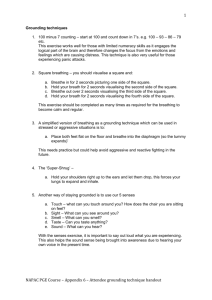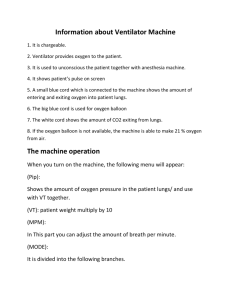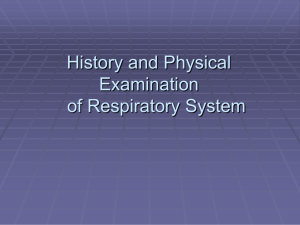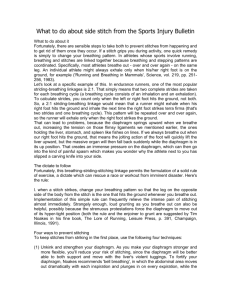WEEK 1 – POSTURE AND BREATHING
advertisement
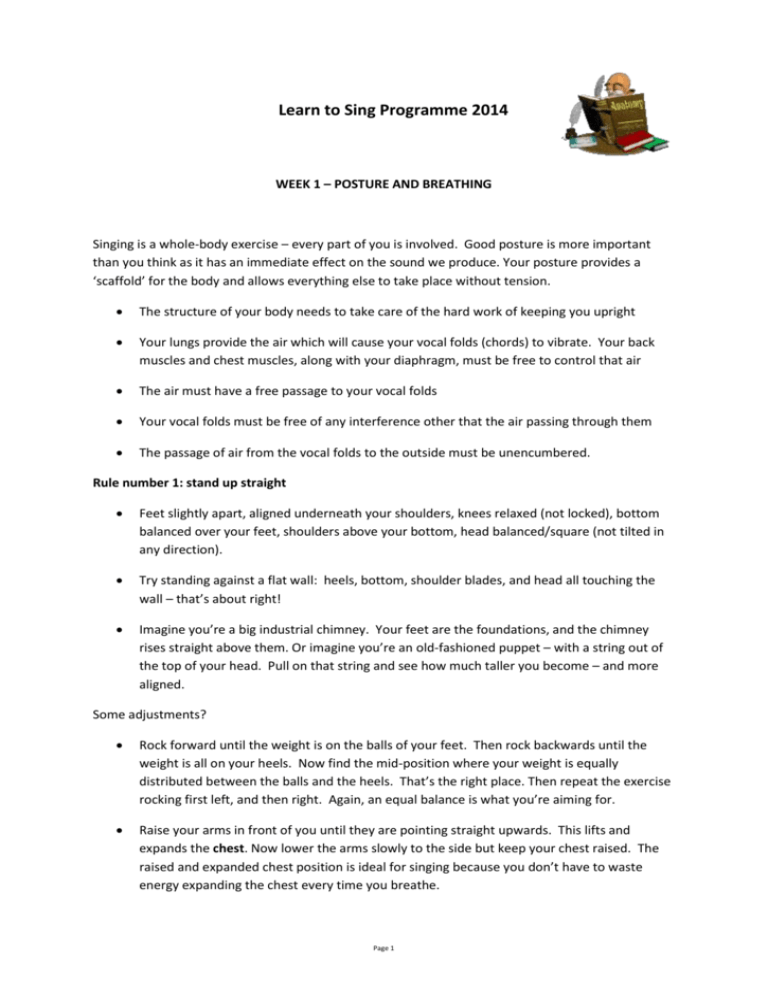
Learn to Sing Programme 2014 WEEK 1 – POSTURE AND BREATHING Singing is a whole-body exercise – every part of you is involved. Good posture is more important than you think as it has an immediate effect on the sound we produce. Your posture provides a ‘scaffold’ for the body and allows everything else to take place without tension. The structure of your body needs to take care of the hard work of keeping you upright Your lungs provide the air which will cause your vocal folds (chords) to vibrate. Your back muscles and chest muscles, along with your diaphragm, must be free to control that air The air must have a free passage to your vocal folds Your vocal folds must be free of any interference other that the air passing through them The passage of air from the vocal folds to the outside must be unencumbered. Rule number 1: stand up straight Feet slightly apart, aligned underneath your shoulders, knees relaxed (not locked), bottom balanced over your feet, shoulders above your bottom, head balanced/square (not tilted in any direction). Try standing against a flat wall: heels, bottom, shoulder blades, and head all touching the wall – that’s about right! Imagine you’re a big industrial chimney. Your feet are the foundations, and the chimney rises straight above them. Or imagine you’re an old-fashioned puppet – with a string out of the top of your head. Pull on that string and see how much taller you become – and more aligned. Some adjustments? Rock forward until the weight is on the balls of your feet. Then rock backwards until the weight is all on your heels. Now find the mid-position where your weight is equally distributed between the balls and the heels. That’s the right place. Then repeat the exercise rocking first left, and then right. Again, an equal balance is what you’re aiming for. Raise your arms in front of you until they are pointing straight upwards. This lifts and expands the chest. Now lower the arms slowly to the side but keep your chest raised. The raised and expanded chest position is ideal for singing because you don’t have to waste energy expanding the chest every time you breathe. Page 1 Learn to Sing Programme 2014 Rule number 2: breathing should be easy, quick and silent Providing you are standing properly, all you need to do is get out of the way and your body will do the rest! You don’t have to suck air in – your lungs will take care of it. The tongue needs to be relaxed and flat in the bottom of the mouth. Your tongue is a huge muscle and can get in the way if you let it! An ‘inner smile’ will get the ‘false folds’ out of the way. These are muscles just above the larynx which help to keep food out of the lungs, but they can also get in the way of effective breathing. Breathe at the beginning of a phrase, not at the end. This helps to maintain tension from the previous phrase and also adds a bit of precision into the starting of the phrase. Now the ugly bit! If you are standing correctly, when you breathe in the chest can’t expand (it’s already expanded remember?), so something else has to help. The diaphragm can move down to create more chest room but, of course, your other bits and pieces (liver, stomach etc) are all in the way. So what happens to all that stuff? Well, it pushes your tummy out! Horrible isn’t it. Breathe in – tummy comes out – breathe out – tummy goes back in again! If this happens, it shows that you’re using correct diaphragmatic breathing. Get in touch with your diaphragm by lying down. Breathe in deeply half a dozen times. It’s almost impossible to do anything other than correct diaphragmatic breathing like this so it’s a good way to find out how it feels. So, now you know some basics, you need to learn how to do a recoil breath – this is also known as SPLAT breathing. Put one hand over your belly button. Without breathing in first, breathe out sharply to a ‘psssshhhhhhh’. Use your hand to send the abdomen right back towards the back bone. Concentrate on an active exhalation – don’t worry about using up all your air. Notice that if you wait and allow your abdominal wall to relax at the end of the sound, the abdomen will bounce outwards and you will have breathed in. Hurrah – and without even thinking about it, you’ve taken a really good breath. Check points – make sure you keep the shoulders relaxed and down – tension in this area can get in the way of freedom in the larynx. Also, make sure you keep your throat open to allow air in – try and take a breath as silently as possible. Page 2 Learn to Sing Programme 2014 So, how can I practice this new skill? These sounds help you to feel a build up of pressure against the air flow. You should feel no pressure in the larynx at the moment as the vocal chords are not involved. Using the following sounds, breathe in between groups of two sounds, four sounds, six sounds etc: Sh sh; sh sh ; sh sh sh sh ; sh sh sh sh; sh sh sh sh sh sh ... Ff ff; ff ff; ff ff ff ff... Ss ss... Now we need to add some voice to these sounds. You should start to feel the larynx vibrating. Again, breathe in between groups of two sounds, four sounds.... Vv vv; vv vv vv vv... Zz zz; zz zz zz zz Je je (as in the French ‘je’) Page 3

